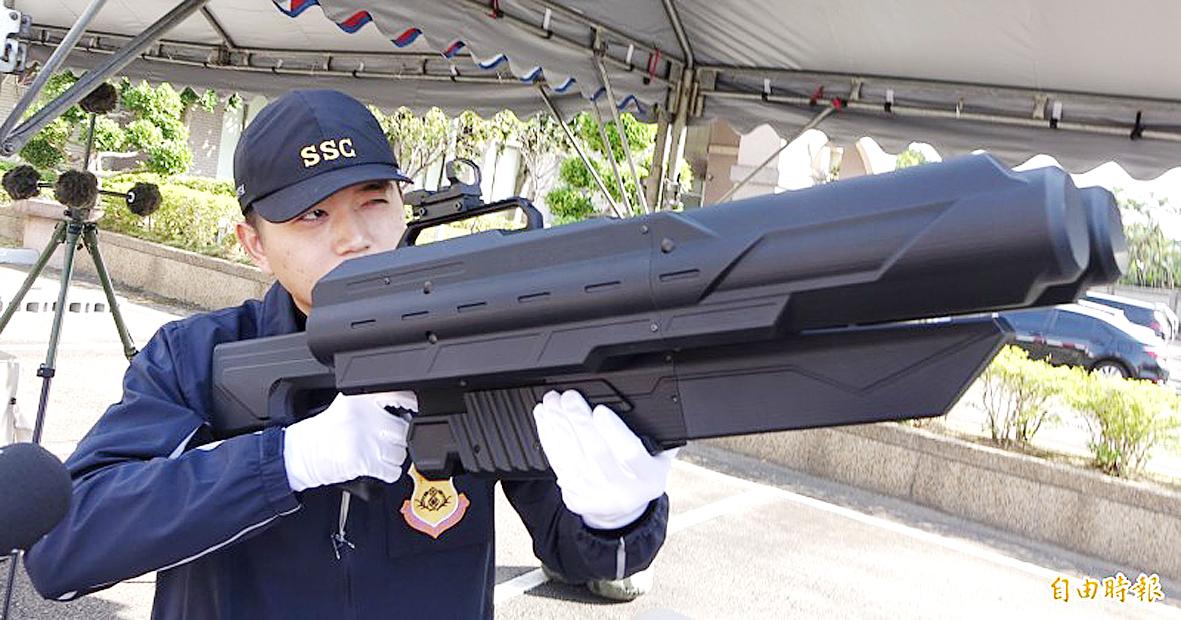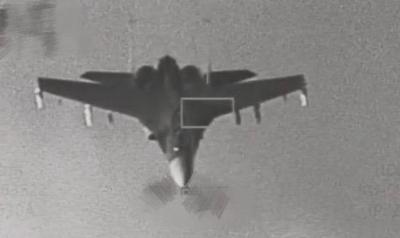The military is looking into countermeasures against the possible use of a “drone swarm” as part of a Chinese “decapitation strike” against Taiwan, a military official said on Saturday.
The comments came after China’s Xinhua news agency reported that Chinese President Xi Jinping (習近平) on Thursday visited the Chinese People’s Liberation Army (PLA) Air Force Aviation University, where he toured its drone experiment labs.
According to the report, Xi instructed the university to put more effort into drone research as the technology is changing how war is conducted, and told the school to improve its production facilities related to drones and step up live combat training for drone operators.

Screen grab from the Liberty Times’ Web site
Beijing has been developing uncrewed aerial and marine vehicles, and has seen marked improvement in its capabilities to use drones, large and small, in strategic deployments and reconnaissance, said a Taiwanese military official, who declined to be named.
The PLA has been focusing on the drone swarm tactic, the official said, adding that the “possibility of Chinese agents in Taiwan operating multiple drones and attacking the Presidential Office, the Executive Yuan or strategic facilities, such as radar stations, cannot be excluded.”
The military has contingencies to handle sudden PLA invasions, attempted decapitation strikes and incidents incited by Chinese agents, and these have been simulated in Han Kuang military exercises, the official said.
Certain agencies have been allocated funding to purchase drone jamming equipment, which has been tested and proven to be effective in countering a potential drone swarm attack on Taiwan, the official added.
In related news, national defense commentator Chieh Chung (?仲) on Friday said that an increase in Chinese nighttime flights near Taiwan’s air defense identification zone (ADIZ) is meant to send a message, to Taiwan and others in the region, that the Chinese air force has significantly improved its combat capability and equipment.
At 7pm on Thursday and 1pm on Friday, PLA jets were sighted in Taiwan’s ADIZ before being chased away, according to reports, although the Ministry of National Defense has not confirmed the sightings, saying that it was “closely monitoring local sea and air activity.”
The first instance of a nighttime sighting of a PLA aircraft near the ADIZ was on March 16, the ministry has said.
That the PLA can overcome the high risk and difficulty in nighttime instrument flights shows a marked improvement in their flight guidance capability and command, control, communications, computer, intelligence, surveillance and reconnaissance ability, Chieh said.
Regarding the increased number of incidents of Chinese military aircraft coming near or crossing into the ADIZ, Chieh said the harassment shows that the PLA Air Force is attempting to strengthen joint-force combat capabilities, step up training for possible combat and ensure distant-strike capability.
A key PLA goal is to keep Taiwan’s southwest ADIZ “under control,” Chieh said, adding that it is highly possible for nighttime Chinese air force activity near the southwest ADIZ to increase.
The ministry should consider measures to ensure that a potential incident would not escalate into a conflict that neither side wants, Chieh said, especially as both sides of the Taiwan Strait lack mutual trust and plans in case of a military incident.

Trips for more than 100,000 international and domestic air travelers could be disrupted as China launches a military exercise around Taiwan today, Taiwan’s Civil Aviation Administration (CAA) said yesterday. The exercise could affect nearly 900 flights scheduled to enter the Taipei Flight Information Region (FIR) during the exercise window, it added. A notice issued by the Chinese Civil Aviation Administration showed there would be seven temporary zones around the Taiwan Strait which would be used for live-fire exercises, lasting from 8am to 6pm today. All aircraft are prohibited from entering during exercise, it says. Taipei FIR has 14 international air routes and

Taiwan lacks effective and cost-efficient armaments to intercept rockets, making the planned “T-Dome” interception system necessary, two experts said on Tuesday. The concerns were raised after China’s military fired two waves of rockets during live-fire drills around Taiwan on Tuesday, part of two-day exercises code-named “Justice Mission 2025.” The first wave involved 17 rockets launched at 9am from Pingtan in China’s Fujian Province, according to Lieutenant General Hsieh Jih-sheng (謝日升) of the Office of the Deputy Chief of the General Staff for Intelligence at the Ministry of National Defense. Those rockets landed 70 nautical miles (129.6km) northeast of Keelung without flying over Taiwan,

City buses in Taipei and New Taipei City, as well as the Taipei MRT, would on Saturday begin accepting QR code payments from five electronic payment providers, the Taipei Department of Transportation said yesterday. The new option would allow passengers to use the “transportation QR code” feature from EasyWallet, iPass Money, iCash Pay, Jkopay or PXPay Plus. Passengers should open their preferred electronic payment app, select the “transportation code” — not the regular payment code — unlock it, and scan the code at ticket readers or gates, General Planning Division Director-General Liu Kuo-chu (劉國著) said. People should move through the

The Ministry of National Defense (MND) today released images of the military tracking China’s People's Liberation Army (PLA) movements during the latest round of Chinese drills around Taiwan. The PLA began "Justice Mission 2025" drills today, carrying out live-fire drills, simulated strikes on land and maritime targets, and exercises to blockade the nation's main ports. The exercises are to continue tomorrow, with the PLA announcing sea and air space restrictions for five zones around Taiwan for 10 hours starting from 8:30am. The ministry today released images showing a Chinese J-16 fighter jet tracked by a F-16V Block 20 jet and the